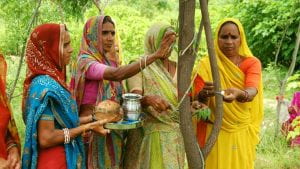In Africa, women and girls are directly affected by the lack of safe drinking water and the lack of sanitation and hygiene. They are mainly responsible for collecting water, which puts them at a greater disadvantage because this task is very hard and time-consuming. Also, they are exposed to sexual abuse while walking to use the toilet. In addition to that, women have certain hygiene needs during menstruation, pregnancy, and child rearing. In other words, this problem affects females more than it affects anyone else.
In the reading by Agarwal, we learn about a different ecofeminist perspective, a non-western perspective. Agarwal says that western society, the United States specifically, explains ecofeminism in terms of ideology. She suggests that in order to end the division between men and women and nature and culture, we must analyze this issue further. For example, “it is critical to examine the underlying basis of women’s relationship with the nonhuman world at levels other than ideology (such as through the work women and men do and the gender division of property and power)” (p. 123). This means that the concept that we have in the United States empowers gender division because by saying that women are more related to nature because of biological factors and that men are more related to culture, we are affirming that this is something that cannot be changed because this is the way it is, period.
Agarwal explains that we need to end this idea that we have created by integrating women into culture and men into nature because although women are certainly biologically closer to nature, that does not mean that we are disconnected from culture and that men are disconnected from nature. In other words, western society has defined ecofeminism in a way that promotes the problem instead of ending it. I agree 100% with the non-western perspective of ecofeminism because the point of creating a movement is to provoke change, not to keep dealing with the same issues. Therefore, the western perspective, although it has some good points, is lacking in this part because it is creating more division between the genders. Also, Agarwal makes a great point about defining ecofeminism in terms of class, gender, race, ecological zones, and castes.
I liked this part because the other readings that I have come across about ecofeminism all define this movement only in terms of gender. However, we should be looking at women as a whole and not only as female vs. male. This raises the point that not all women are the same, therefore, not all women face the same types of issues when it comes to nature. The types of issues a woman faces are greatly affected by where she comes from, her skin color, her economic status, etc. For example, women in India are more affected by the destruction of nature because they get most of their food to feed their families from nature. These women have an even bigger attachment to nature because of their ecological zone, class and caste. On the other hand, a woman that lives in the United States and has more access to goods, is not going to have the same attachment to nature, but she might relate to nature in a different way.



Natalia,
I really appreciate Agarwal’s perspective because she is making it a point to integrate men AND women in the sense that we need to represent men in nature more and also women into culture. I do believe that a great way to eliminate oppression is to include all genders in all aspects of society such as nature and culture, etc… the ideology that all genders are included in feminism is important to me and also serves as an important message for intersectionality as well. This ties into also, when Agarwal stated that women and men have had different representations throughout different time periods and cultures, “such a formulation flies in the face of wide-ranging evidence that concepts of nature, culture, gender, and so on, are historically and socially constructed and vary across and within cultures and time periods” (Agarwal 123). The roles that have been bestowed upon both women and men throughout modern Western civilization serve as a method of oppression and limitation. These ‘roles’ should be broken through and should be more fluid and interchangeable.
Hi Natalia!
I very much agree with all the points you have made. Both men and women should be connected to nature to some degree. It almost seems counterproductive in a small way, if you think about it, to link women to nature’s plight to that of women’s without integrating men into the scenario as well. Granted, theories from Vandana Shiva give the perspective that oppression stems from the patriarchy, which I would definitely not dispute, but it seems as though men aren’t as heavily included in the theories as they should. Many resolutions discuss how feminist thought can provide for ideology and action that can contribute to bettering environmental degradation, but not how men can connect to this cause. Without the connection of men, it feels like the burden is solely up to women to overcome while further perpetuating the gender gap. This definitely links to Agarwal’s mention of essentialism to the fact that it seems as though the link between nature and women being unchangeable (Agarwal 123).
I feel as though your point toward the end of your response about considering the differing experiences of women can connect to one of Karen Warren’s connections, the empirical and experiential connection. This to me, feels like the most “material” part of ecofeminism that Bina Agarwal states in her article. With considering the information being given and statistical odds of women being impacted i certain ways by nature’s oppression, we are able to connect women’s real, lived experiences to the ideology of Western ecofeminism to make it into a more cohesive and inclusive concept.